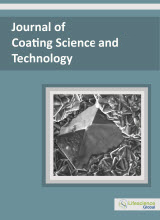jcst
Abstract : Simulation of Micro-Precoating Effect on Temperature Distribution in Plasma Thermal Spraying
|
|
|
Abstract: The effect of micro-precoating on temperature distribution of the plasma thermal spraying was simulated. After the plasma thermal spraying test with SS304 as precoating, the effect of micro-precoating on the wear loss and fatigue had been studied preliminarily. Results show that the surface temperature with micro-precoating is higher than that of without micro-precoating. Meanwhile, the heat affected zone with precoating is wider which effectively restrains the microcracks forming in the succedent coating. Subsequently, the wear and fatigue of the plasma thermal spray coating are significantly increased with the optimum micro-precoating thickness. Keywords: Simulation, Temperature distribution, Micro-precoating, Thermal spraying. |
Abstract : Enhancing the Thermal and Mechanical Properties of Organic-Inorganic Hybrid Nanocomposite Films Based on Poly Lactic Acid/OMMT Nano Clay
|
|
|
Abstract: Organic (PLA) inorganic (OMMT nano clay) hybrid nanocomposite films were fabricated using poly lactic acid (PLA) with various weight percentages (1-3wt%) of organically modified montmorillonite (OMMT) nano clay by means of one step solvent casting method. The thermal, mechanical and water absorption properties were determined as per standard testing methods to determine the optimum percentage of OMMT nano clay within the nanocomposite was investigated. The surface morphology of the organic-inorganic hybrid nanocomposite films was analyzed through XRD, SEM, and TEM surface analytical techniques. The incorporation ofOMMT clay in to PLA matrix is found to have enhanced the thermo-mechanical properties. The water absorption and solubility test resultsalso support the data from thermo-mechanical tests. The 2 wt % OMMT clay loaded PLA films showed the best results among all. The obtained results showed that the thermal, mechanical and water absorption properties could be increased significantly with the optimum incorporation of OMMT nano clay in a PLA matrix, in comparision wih the neat PLA. Keywords: PLA, OMMT nano clay, Mechanical properties, Thermal stability, Surface morphology, Water absorption. |
Abstract : Effect of Milling Time on Surface Morphology of AISI O1
|
|
|
Abstract: AISI O1 was processed by surface milling and the influence of milling time on the surface morphology was studied by 3D profilometer and scanning electron microscopy (SEM). Results show that when AISI O1 specimens are processed with various milling time, the morphology of AISI O1 changes correspondingly. Moreover, it demonstrates that the initial increase in milling time accompanies with the increase in surface roughness until the milling time reaches 60 min at which the surface roughness is the minimum. Keywords: Milling, surface morphology, roughness, AISI O1. |
Abstract : Diamond Deposition on Graphite in Hydrogen Microwave Plasma
|
|
|
Abstract: Hydrogen plasma etching of graphite generates radicals that can be used for diamond synthesis by chemical vapor deposition (CVD). We studied the etching of polycrystalline graphite by a hydrogen microwave plasma, growth of diamond particles of the non-seeded graphite substrates, and characterized the diamond morphology, grain size distribution, growth rate, and phase purity. The graphite substrates served simultaneously as a carbon source, this being the specific feature of the process. A disorder of the graphite surface structure reduces as the result of the etching as revealed with Raman spectroscopy. The diamond growth rate of 3 – 5 µm/h was achieved, the quality of the produced diamond grains improving with growth time due to inherently nonstationary graphite etching process. Keywords: Microwave plasma, diamond deposition, hydrogen plasma, graphite, etching. |






















